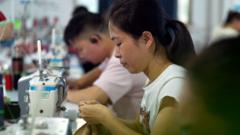**As Shein's fashion empire expands rapidly, concerns regarding worker exploitation and labor conditions emerge, revealing a contrasting reality behind its low prices.**
**Unveiling the Factory Secrets Behind Shein's $12 Dresses**

**Unveiling the Factory Secrets Behind Shein's $12 Dresses**
**A Deep Dive into the Working Conditions of Shein's Supply Chain in Guangzhou, China**
In Guangzhou, a bustling port city on the Pearl River, the sound of sewing machines resonates throughout the "Shein village," a hub for the world's largest fast fashion retailer. This district is home to approximately 5,000 factories—many supplying Shein—and operates relentlessly to satisfy demand for trendy apparel across more than 150 countries. A worker candidly expressed, "If there are 31 days in a month, I will work 31 days," highlighting the grueling expectation to toil long hours, sometimes just one day off a month.
Recent investigations have shed light on alarming labor practices, with many workers clocking 75 hours a week, which contravenes Chinese labor laws mandating a 44-hour average workweek. Shein, originally a modest venture, has surged in valuation up to $66billion within five years, but this meteoric rise has stirred controversy over its treatment of workers and accusations of forced labor.
In a statement, Shein affirmed its commitment to fair worker treatment and announced plans to invest millions in compliance improvements. However, the realities of factory life paint a different picture. In Panyu, workers earn meager wages, often less than a dollar per t-shirt produced, while reports from advocacy groups like Public Eye point out the systemic exploitation deeply rooted in this industry.
Factory owners describe the high volumes of orders dictated by Shein’s algorithms, resulting in a blend of increased production pressure and constrained profits. A local supplier recalled the transition from independent sales to the harsh cost-cutting strategies imposed by Shein.
Despite these challenges, many workers express a sense of pride in their contribution to the global fashion scene, with one factory owner acknowledging Shein’s impact on their livelihoods. “It pays on time,” said one supplier, emphasizing the brand's reliability amid a harsh working environment.
The juxtaposition of Shein’s incredible market growth against the backdrop of these exploitative labor practices raises urgent questions about ethical consumption and the sustainability of such rapid industrial expansion. As more consumers worldwide seek cheap fashion, advocates urge comprehensive scrutiny and reforms within the sector to ensure the dignity and rights of workers are upheld.
Recent investigations have shed light on alarming labor practices, with many workers clocking 75 hours a week, which contravenes Chinese labor laws mandating a 44-hour average workweek. Shein, originally a modest venture, has surged in valuation up to $66billion within five years, but this meteoric rise has stirred controversy over its treatment of workers and accusations of forced labor.
In a statement, Shein affirmed its commitment to fair worker treatment and announced plans to invest millions in compliance improvements. However, the realities of factory life paint a different picture. In Panyu, workers earn meager wages, often less than a dollar per t-shirt produced, while reports from advocacy groups like Public Eye point out the systemic exploitation deeply rooted in this industry.
Factory owners describe the high volumes of orders dictated by Shein’s algorithms, resulting in a blend of increased production pressure and constrained profits. A local supplier recalled the transition from independent sales to the harsh cost-cutting strategies imposed by Shein.
Despite these challenges, many workers express a sense of pride in their contribution to the global fashion scene, with one factory owner acknowledging Shein’s impact on their livelihoods. “It pays on time,” said one supplier, emphasizing the brand's reliability amid a harsh working environment.
The juxtaposition of Shein’s incredible market growth against the backdrop of these exploitative labor practices raises urgent questions about ethical consumption and the sustainability of such rapid industrial expansion. As more consumers worldwide seek cheap fashion, advocates urge comprehensive scrutiny and reforms within the sector to ensure the dignity and rights of workers are upheld.



















